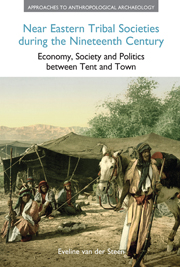 Near Eastern Tribal Societies during the Nineteenth Century
Near Eastern Tribal Societies during the Nineteenth Century Book contents
- Frontmatter
- Dedication
- Contents
- Acknowledgements
- Introduction
- 1 What is a tribe?
- 2 Travellers in the Levant during the nineteenth century
- 3 The dynamics of territorial and power structures
- 4 Oral traditions
- 5 Tribal society and its relation to the landscape
- 6 Tribal institutions
- 7 Relations between the tribes and the state
- 8 From tribe to tribal state: three case studies
- 9 The economy of tribal societies
- 10 Ethnicity and the sense of belonging
- 11 Women in tribal societies
- 12 Religion and folklore
- 13 Back in time: historical parallels
- Notes
- References
- Index
5 - Tribal society and its relation to the landscape
- Frontmatter
- Dedication
- Contents
- Acknowledgements
- Introduction
- 1 What is a tribe?
- 2 Travellers in the Levant during the nineteenth century
- 3 The dynamics of territorial and power structures
- 4 Oral traditions
- 5 Tribal society and its relation to the landscape
- 6 Tribal institutions
- 7 Relations between the tribes and the state
- 8 From tribe to tribal state: three case studies
- 9 The economy of tribal societies
- 10 Ethnicity and the sense of belonging
- 11 Women in tribal societies
- 12 Religion and folklore
- 13 Back in time: historical parallels
- Notes
- References
- Index
Summary
“By God!” said he, “the plain is covered with places wherein I rested.” He had struck the note. I looked out beyond him into the night and saw the desert with his eyes, no longer empty but set thicker with human associations than any city. Every line of it took on significance, every stone was like the ghost of a hearth in which the warmth of Arab life was hardly cold, though the fire might have been extinguished this hundred years. It was a city of shadowy outlines visible one under the other, fleeting and changing, combining into new shapes elements that are as old as Time, the new indistinguishable from the old and the old from the new.
(Gertrude Bell, The Desert and the Sown, 1907)Introduction
Landscape: the geography, geology, climate and ecosystem of a region or country play a vital role in almost all aspects of society. Mountains and wadis define the land and give it structure and meaning for those who live in it. Natural resources such as water and fertile soil are vital for survival, and therefore a major cause of territorial conflict. Territorial rights and ownership of the land continually shaped and reshaped settlement patterns and power structures.
For Western travellers to the Near East, the landscape had a different meaning. Palestine and parts of Transjordan were the land of the Bible, and they saw the biblical stories of the Exodus, Joshua and the Judges re-enacted in the daily life of Bedouin and fellahin. The black tents of the Bedouin were like the tents of the Israelites, and the Shepherd King Mesha could be a shaykh of the Beni Sakhr or the Adwan. They identified biblical sites in the names of modern villages and ruins, either systematically, as Edward Robinson did, or simply as an erudite pastime in the manner of Burckhardt or de Saulcy. Their “biblical” outlook could influence their observations.
- Type
- Chapter
- Information
- Near Eastern Tribal Societies during the Nineteenth CenturyEconomy, Society and Politics between Tent and Town, pp. 80 - 104Publisher: Acumen PublishingPrint publication year: 2013


